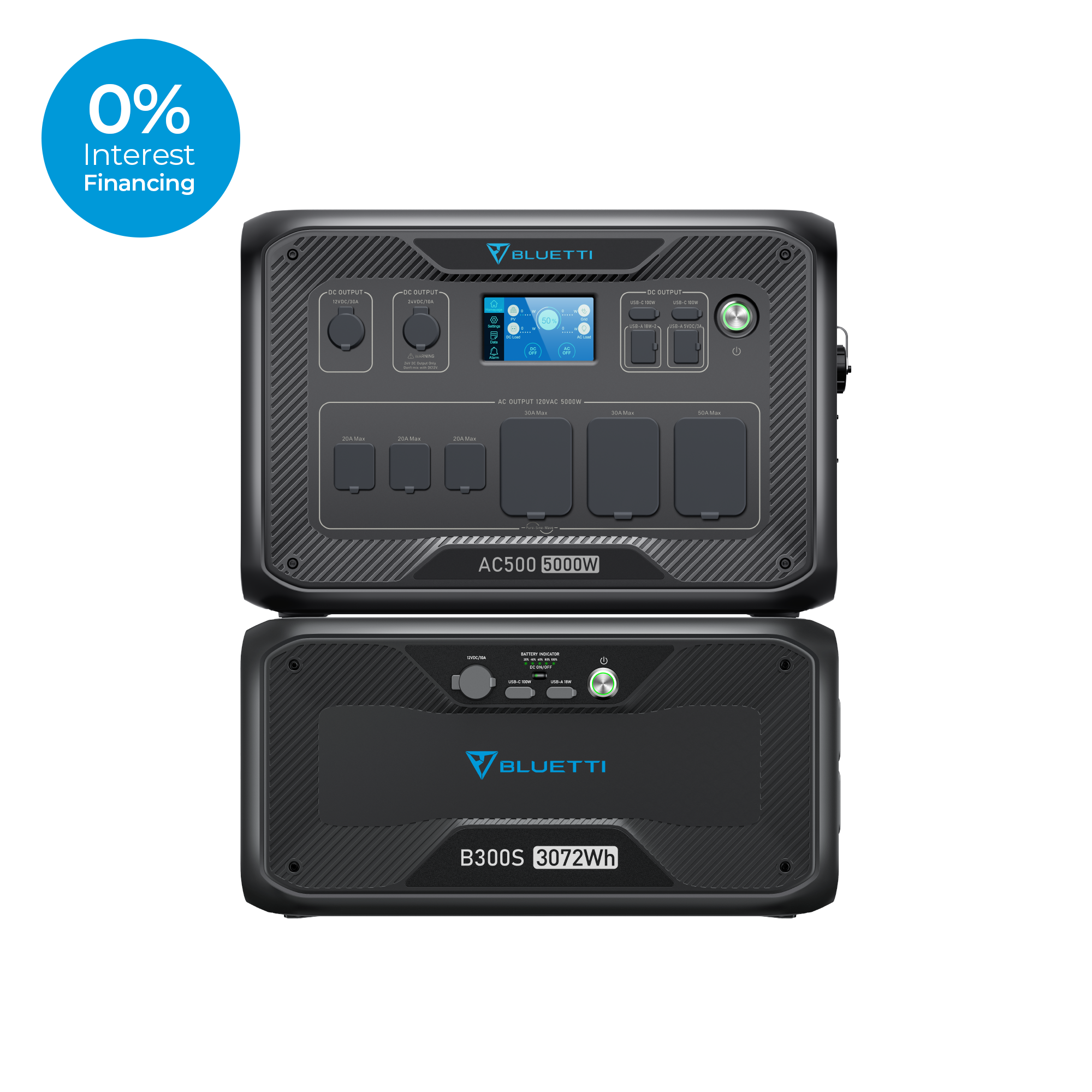Your cart is empty
Shop our productsSolar system installation is gaining traction in most states. Off-grid solar enables you to be energy independent, cut down or eliminate electricity bills, and reduce your carbon footprint.
Are you planning on installing an off-grid solar system in your home? Do you know how much it costs and all the components required for the installation?
This article lets us explore all the aspects of off-grid living, how it differs from the on-grid system, factors to consider when installing the off-grid solar system, and the off-grid solar system costs. Keep reading if you are interested in transitioning to off-grid living.
What Is an Off-Grid Solar System?

An off-grid solar system, also known as a stand-alone power system (SAPS), is a system that generates electricity by tapping the sun's energy and storing the energy in the batteries. The off-grid system operates independently from the grid system. An off-grid solar system encourages a lifestyle centred around self-sustainability and independence regarding energy.
More people are adopting the off-grid lifestyle due to the ever-rising costs of electricity, high costs of living, and life in general.
Off-Grid vs. On-Grid Solar Systems
There are two types of grids: the off-grid and the on-grid solar system. The on-grid system connects to an already established electricity system that enables you to access power from a utility company.
The off-grid solar system does not rely on the utility company to supply power. The off-grid system generates power and stores energy in the battery for continued and future use.
When choosing between on-grid and off-grid systems, you should consider factors such as the electricity costs in your area and the amount of sun you receive.
Cost by Solar System Size
The solar systems come in different sizes, which also influences the costs. For instance, a bigger solar system means more panels, and the costs will be higher than a smaller system with fewer solar panels: the more solar panels, the higher the energy output and vice versa.
Note: A bigger solar system will cost you more money to install. However, it is the most viable option to save money in the long run.
The average cost for installation of a 6kW to 12kW solar system ranges between $5,400 to $18,000. With the installation costs included, the costs could rise to $6,600 and $22,800.
Cost by Solar System Type
There are different types of solar systems. They vary in size, efficiency, durability, and output. If you are working with minimal roof space, you will require fewer or smaller yet highly efficient solar panels.
The three major types of solar panels are the monocrystalline, the thin-film, and the polycrystalline panels.
1. Monocrystalline Panels
The monocrystalline solar panels are by far the most popular for residential installations. Also, they are the most expensive. They have the highest efficiency rate, ranging from 17% to 22%. On average, the monocrystalline solar panel per watt ranges from $1 to $1.50, meaning a 6KW solar panel system will cost anywhere from $6,000 to $9,000. The monocrystalline solar panels have a lifespan of 25 to 40 years.
2. Thin-Film Solar Panels
The thin-film solar panels are the least expensive, with an efficiency rate ranging from 7% to 13%. They have a short life span of 10 to 20 years. The thin-film solar panels are rarely used in residential settings. They are more suitable for industrial settings because they require a large space.
The costs of thin-film panels per watt range between $0.75 and $1.10, which means a 6Kw panel system will cost between $4,500 and $6,600.
3. Polycrystalline Panels
Polycrystalline solar panels are efficient but not as high as monocrystalline solar panels. Polycrystalline panels per watt range from $0.75 to $1, meaning a 6KW solar panel system will cost between $4,500 and $6,000. It is a more affordable option for residential and industrial installations. The efficiency ranges from 15% to 17%, with a lifespan of 25 to 30 years.
A Table Comparison of the Solar Panel Types by Costs
|
Panel Type |
Monocrystalline |
Polycrystalline |
Thin-Film |
|
Costs (W) |
$1–$1.50 |
$0.75 to $1 |
$0.75 - $1.10 |
|
Costs(KW) |
$6,000 -$9,000 |
$4,500- $6,000 |
$4,500- $6,600 |
|
Efficiency |
High 17%–23% |
Moderate (15%–17%) |
Low (7%–13%) |
|
Life-Span |
25 to 40 years |
25 to 30 years |
10 to 20 years |
Cost by Solar System Component
There are several components required for the proper functioning of the solar system. They include solar panels, batteries, a Solar charge controller, an inverter, an electric meter, and the sun.
1. Solar Panels
Panels are the major components of the solar system. The cost of a solar system varies depending on the brand and the size of your solar system. On average, it will cost you $2.76 per watt. Most solar panels have between 250 and 400 watts.
2. Solar Battery
Another crucial component of the solar system is the battery for energy storage. The cost of the solar battery ranges between $4,000 and $14,000.
3. An Inverter
An inverter converts the DC energy into AC energy. The cost of an inverter varies depending on the level of advancement. The price ranges between $3,000 to $13,000.
4. Solar Charge Controller
The solar charge controller regulates the energy tapped from the solar panels to avoid overloading the battery. The average cost of a charge controller is $500 and $600. Advanced models of solar charge controllers can cost up to $2,000.
|
Component |
Average Cost |
|
Solar Panels |
$2.76 per watt |
|
An Inverter |
$3,000 to $13,000 |
|
Solar Charge Controller |
$500 to $600 |
|
Solar Batteries |
$4,000 to $14,000 |
|
Solar Generators |
$10,000 to $20,000 |
Factors Affecting Off-Grid Solar System Costs
As discussed above, the off-grid solar system does not rely on the grid for energy. You have to create your off-grid solar system from scratch. This can be an expensive affair but much worthwhile in the long run. If you are considering installing an off-grid solar system, here are the factors you must consider.
1. The Size of the System
Solar power is measured in kilowatts (kW) or megawatts (MW). The size of the solar system impacts the costs. If you want a larger system, you will require more panels, larger batteries and other components, increasing the overall costs.
2. The Location
Your location will affect the cost of installing the off-grid solar system. The sun you receive in your location will determine the number of panels sufficient for generating enough electricity—the more panels, the higher the costs.
3. Maintenance
You need to factor in not just the installation costs but also the maintenance costs. Maintenance will include regularly inspecting the system, cleaning the panels, and replacing some components.
4. Installation and Wiring
The type of installation and wiring will also impact the overall costs of the off-grid system. For instance, are you mounting the panels on the roof or the ground? What is the length of the wiring and the number of components to be installed?
Solar Incentives and Credits
As seen above, the upfront costs for installing solar panels are high, running up to thousands of dollars. The Federal government, through the Solar Investment Tax Credit (ITC) and federal tax credit, refunds up to 30% off your installation costs. Check out your state's solar incentives, credits, and rebates to reduce installation costs. California, New York, Minnesota, and Texas are some states with high solar incentives.
How to Build Your Off-Grid Solar Energy System?
An off-grid system is a huge investment that requires careful planning. You must determine the electrical load or energy needs before installing the system. Additionally, consider each component while ensuring they are compatible with each other and the system. Some solar brands, like BLUETTI, have universal solar components compatible with every solar system and other equipment.
Building a solar system is complex, and you might require an expert to help you. Although you can DIY the installation, you will still need an expert to fine-tune the installation.
Here is a guide for building an off-grid solar system from scratch.
1. Determine Charge Load
You can use your electrical bills to calculate your electrical load. You can do this by checking your electricity bill for the year and dividing by each month. Also, you can check the wattage of your appliances and devices to arrive at an accurate electrical load.
2. Pick a Battery
The role of the solar battery is to preserve solar energy for later use. We recommend the BLUETTI Expansion Batteries.
B300 Expansion Battery | 3,072Wh

Specifications
- Capacity: 3,072Wh (51.2V, 60Ah)
- Battery type: LiFePO4 (Lithium Iron Phosphate)
- Life cycles: 3500+ Cycles to 80% Original Capacity
- Life: Up to 80% Every 3-6 Months
- Management system: MPPT Controller
- Output: USB-C Port, 12V DC Outlet, USB-A Port
- Input: Solar, AC, car
- Operating and storage temp: -4-104℉ (-20-40℃)
- 240V Split Phase Bonding: Yes
- Weight: 79.6lbs (36.1kg)
3. Charge Controller
Every solar battery needs a charge controller. Usually, there are two types of charge controllers: 12V and 24V. The voltage of the controller must align with the inverter. Different types of charge controllers are the Maximum Power Point Tracking (MPPT) and Pulse width modulation (PWM).
4. Choose the Inverter
Inverters come in 12V and 24V and are necessary if you install a DC system. The inverter's voltage should match that of the charge controller, batteries and solar panels.
5. Solar Panels
The solar panels should align with the voltage of the entire system. The number of solar panels you need depends on your energy needs. Also, your location and the amount of sun you receive matter. Some of the solar panels to consider are the BLUETTI solar panels.
BLUETTI PV420 Solar Panel | 420W

Features
- Conversion: 23.4% conversion rate
- Cell type: Monocrystalline Silicon
- Power: 420W
- Material: Durable, splash-proof, and Long-lasting ETFE Coating
- Mode: Foldable & portable
- 420W solar power for fast charging
- Open Circuit Voltage(OCV): 44.3V
- Connector: Standard MC4
- Operating temperature: 14℉-149℉/-10℃-65℃
- Compatibility: BLUETTI AC200P, AC200MAX, AC300, AC500, EB150, EB240, EP500, and EP500Pro
6. Connect the Components
Items required for connecting all the solar system components are wires, infusers, metering devices, cables, and balance-of-system devices. The components help in regulating safe electricity transmission. This stage is complex, and a solar expert best handles it.
Final Thoughts
The off-grid solar system is a big investment that pays off in the long run. The benefits of off-grid living are numerous, from saving costs on electricity, energy independence, energy efficiency, and reducing the carbon blueprint.
If you are installing the off-grid system, you must get all the facts right, from the off-grid solar system costs, the components needed and costs, and the incentives and credits, as discussed above. Get the price estimates from various solar companies and get the best deals.
Shop products from this article
Be the First to Know
You May Also Like

What Does a 30% Federal Solar Tax Credit Mean and How to Apply?
Governments around the world are offering programs that encourage homeowners to switch to solar energy. Among the most notable programs is the 30% Federal Solar Tax Credit. It reduces your...

Deadly Flooding Devastates U.S. South and Midwest — What You Need to Know


















































































































































































































































